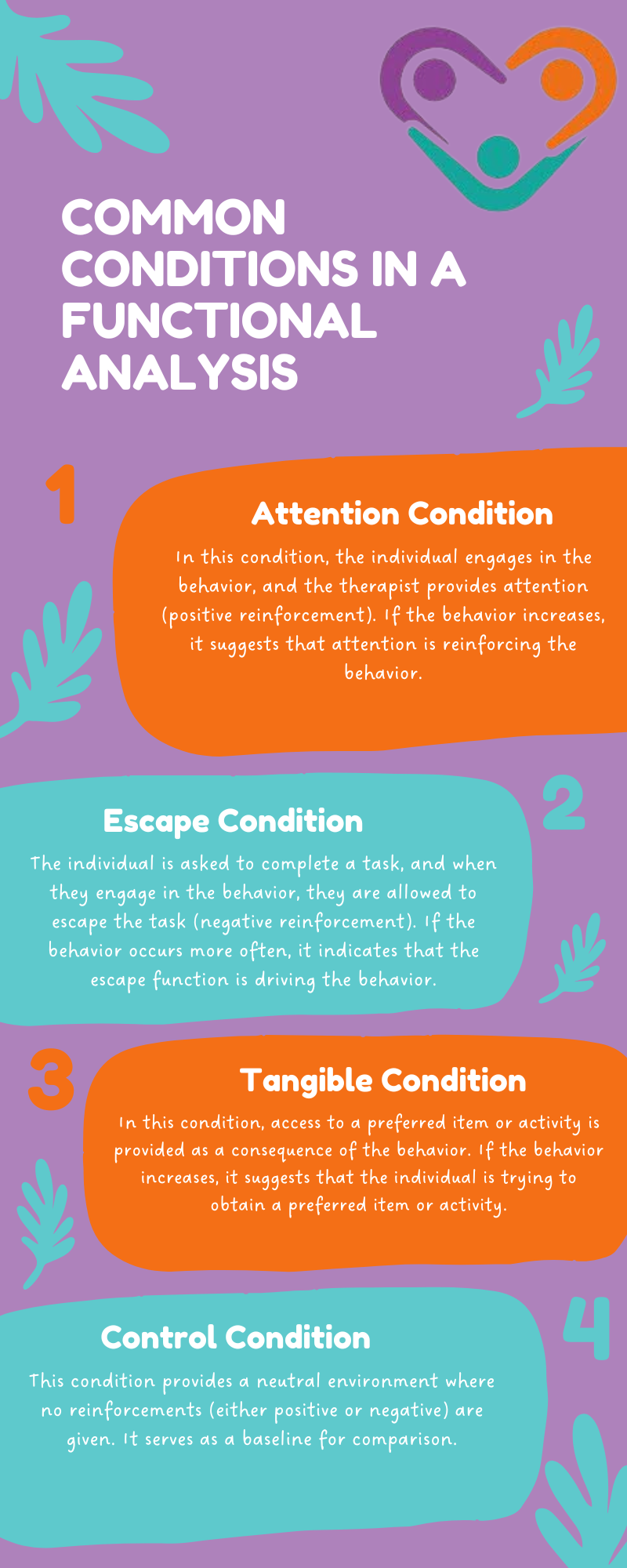Functional analysis is a core concept in Applied Behavior Analysis (ABA) therapy. It involves identifying the underlying causes of specific behaviors, thus allowing clinicians to develop more effective evidence-based interventions.
In the context of autism therapy, functional analysis can be a vital tool for addressing problem behaviors that might hinder progress in other areas of development.
Here, we will break down the steps involved in conducting a functional analysis using an ABA example. This process helps determine why certain behaviors occur and how to intervene effectively.
What is Functional Analysis in ABA?
Functional analysis in ABA is a systematic process used to determine the function of a behavior. Every behavior serves a purpose, whether to gain attention, escape from a task, or obtain a tangible item.
Functional analysis helps to pinpoint these underlying reasons, making it easier to develop interventions that address the root causes of the behavior rather than just managing the behavior itself.
The primary goal of functional analysis is to identify which environmental variables maintain or trigger problem behaviors, which allows for targeted intervention strategies.
The key components of functional analysis include the following:
- Antecedents: The events or circumstances that occur before the behavior.
- Behavior: The actual action or response of the individual.
- Consequences: The outcomes or reactions that follow the behavior, which can either reinforce or discourage it.
Functional analysis is typically conducted in a controlled environment where different conditions are systematically manipulated. The goal is to observe how changes in these conditions affect the behavior in question.
That said, functional analysis typically includes the following common conditions:

The data collected during these conditions helps therapists determine the primary function of the behavior, guiding the development of more effective interventions.
Example of Functional Analysis in ABA Therapy: A Case Study
To better understand how functional analysis works, let’s walk through an ABA example. Suppose a child in a therapy program begins to display aggressive behavior, such as hitting or throwing objects, during sessions.
Step 1: Conducting the Functional Analysis
In this case, the ABA therapist might set up the following conditions to determine the function of the aggressive behavior:
- Attention Condition: The therapist may ignore the child until the aggressive behavior occurs. When the child engages in hitting or throwing objects, the therapist gives them attention (e.g., verbal praise or physical proximity).
- Escape Condition: The child is asked to complete a task, such as a simple puzzle or coloring activity. If the child begins to display aggressive behavior, the therapist allows the child to avoid the task (escape).
- Tangible Condition: The child is given access to a favorite toy or item, and when aggressive behavior occurs, access to the toy is given as a consequence.
- Control Condition: In this neutral condition, the therapist provides no specific attention, no task demands, and no access to preferred items.

Step 2: Analyzing the Data
After observing the child’s behavior under these different conditions, the therapist analyzes the data to identify patterns. In this case, if the aggressive behavior primarily occurs during the Escape Condition, it suggests that the child is using aggression to avoid or escape tasks they find unpleasant or difficult.
Step 3: Developing an Intervention
Once the therapist has identified the function of the behavior (in this case, escape), they can develop an intervention strategy that addresses the root cause. The therapist might:
- Teach Alternative Behaviors: Instruct the child on how to appropriately communicate when they want to escape a task (e.g., asking for a break).
- Modify Task Demands: Make the tasks more manageable by breaking them down into smaller, more achievable steps to reduce frustration.
- Reinforce Alternative Behaviors: Provide positive reinforcement for using appropriate escape behaviors, such as requesting a break.
This intervention plan will focus on teaching the child functional communication skills to meet their needs in a more acceptable way.
Why Functional Analysis is Essential in ABA Therapy
Functional analysis plays a crucial role in ABA therapy by providing a structured way to understand and address problem behaviors. Rather than focusing solely on stopping undesirable behaviors, functional analysis allows therapists to identify the underlying motivations driving the behavior.
This results in more effective, individualized interventions that are more likely to produce lasting behavior change.
Needless to say, functional analysis is a powerful tool within the field of ABA therapy, allowing clinicians to gain insight into the motivations behind problem behaviors. By identifying whether behaviors are being reinforced by attention, escape, access to tangibles, or other factors, therapists can design interventions that address the core of the issue.
For families and individuals seeking autism services, working with qualified ABA professionals who utilize functional analysis can make a significant difference in the success of the therapy program.
Whether you’re addressing challenging behaviors or enhancing skill development, functional analysis provides the clarity needed to create effective, lasting interventions. At Golden Care Therapy ABA, we deliver high-quality ABA therapy in New York, New Jersey, Indiana, Georgia, and Florida, tailored to meet the unique needs of every individual we serve.
Our experienced team is dedicated to creating compassionate, results-driven strategies that foster meaningful progress. Contact us today to learn how we can support you or your loved one on this journey. Let’s work together to achieve impactful, lasting change.
Sources:



